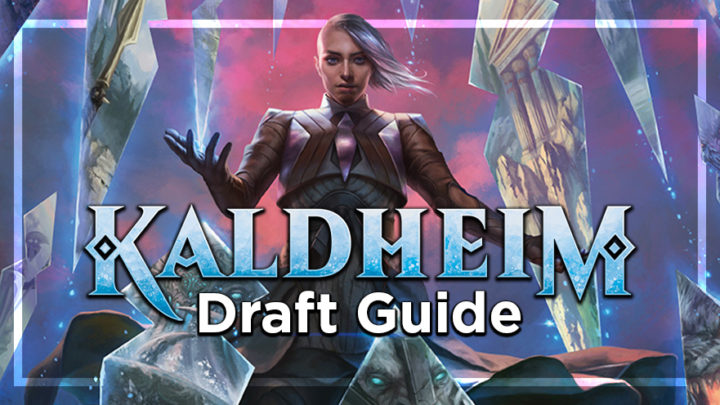Hello, friends! Kenji “NumotTheNummy” Egashira here for an initial dive into the fabulous world of Kaldheim. As a Limited aficionado, I often find getting the opinions of new cards from various individuals can be very eye-opening when it comes to understanding how a format plays out. This will be my attempt at, hopefully, giving you one of those eye-opening moments and helping you better understand the intricacies and/or powerful cards you should be aware of in a Draft or Sealed environment.
This, however, will not be an entire set review devoted to giving a letter or number grade to each card; I often find those grades are not useful when looking at the entire picture of a format. Instead, I want to provide an overview of what Kaldheim is all about and share my top commons and uncommons in each color. Just remember, this is an initial look at the format and my baseline conclusions. As a format evolves and we have more time to play with it, so should our opinions evolve to shape our better understanding.
Kaldheim Mechanics
Kaldheim is a fantastic story-driven set that takes place in a setting inspired by Norse mythology. The art and cards call back images and stories of Vikings and beasts clashing, while Gods linger in the background. Besides the fantastic art that brings this all to life, we also get a taste of this during the actual gameplay with a bunch of new mechanics that build around the themes at hand.

The two new mechanics introduced in Kaldheim and boast and foretell – both powerful abilities that can give you an upper hand in defeating your foes. Boast is an activated ability of a creature that can only be used if the creature attacked that turn, and only once each turn. A creature’s boast ability is public information, so you can’t really “trick” your opponent, so to spea; while some of these abilities are quite powerful, there aren’t going to be too many ways to abuse them.
Foretell, meanwhile, is an ability that lets you pay two generic mana at any point on your turn to exile the foretold card. On a later turn, you are then able to cast that spell for whatever the foretell cost is. As you’ll come to learn, there are plenty of different foretell cards that are playable and have a wide variety of abilities. Since your opponent doesn’t get to know what card you’re using the foretell ability on, there is a bit of a guessing game that they have to play. This can allow you to get in for that extra point of damage, prevent your opponent from casting a removal spell too early, force bad blocks, etc.
So, what are some of the cards that use boast or foretell? Let’s find out. Next up, I’ll detail some of the major draft archetypes and what themes and key cards they use, including those with the two new abilities we’ve just learned about.
Kaldheim Draft Archetypes
White/Blue
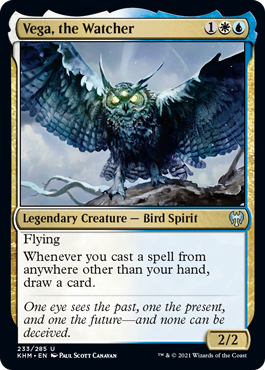
White/Blue is a common theme in any draft environment, one that excels at controlling the game and usually winning with flying creatures. Headlining this color combination is the powerful Vega, the Watcher, which conveniently works well with foretell cards. Cards such as Doomskar Oracle, Iron Verdict, Behold the Multiverse, and Ravenform can all serve to advance your plan while delaying the opponent.
Blue/Black
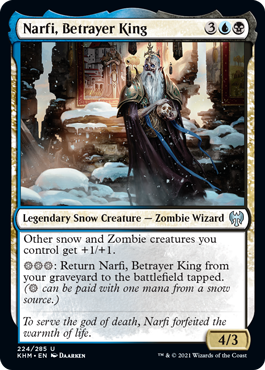
Zombies and snow cards are the main strategy of this color pair, and no card exemplifies this more than Narfi, Betrayer King. One important aspect of this strategy, and one that encompasses all snow decks, is that you must draft any snow lands that you want to include in your deck. As a result, you’ll have to learn when to prioritize taking a snow land in place of a playable card for your deck. Keep your eyes open for cards like Avalanche Caller, Draugr Thought-Thief, Grim Draugr, and Priest of the Haunted Edge.
Black/Red
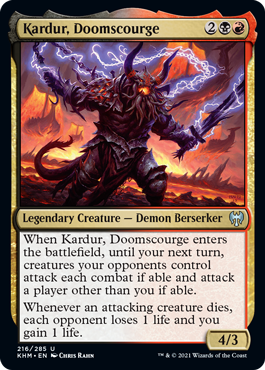
Aggressive creatures and strong boast mechanics are the major selling points of the Black/Red deck in Kaldheim. Headlined by one of the more potent uncommons, Kardur, Doomscourge, this deck can run people over in a hurry. Look for signals such as Bloodsky Berserker, Jarl of the Forsaken, Fearless Liberator and Tuskeri Firewalker.
Red/Green
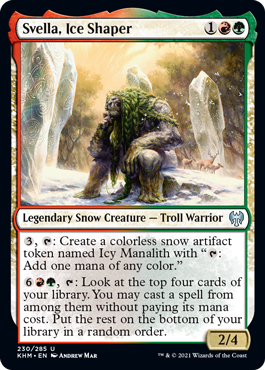
When I think of the Red/Green color combination, I think of efficient creature threats and burn spells – and that basically holds true for this set. Svella, Ice Shaper is the herald of this color pair, and look for cards like Axgard Cavalry, Craven Hulk, Sarulf’s Packmate and Struggle for Skemfar.
Green/White
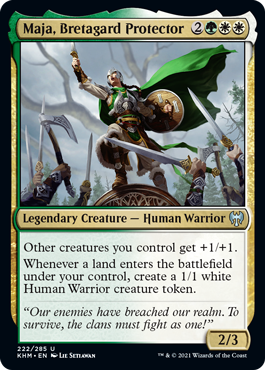
This is the “go wide” strategy, meaning you’re trying to play a bunch of smaller threats that can overwhelm the opponent before they can stabilize. Maja, Bretagard Protector is the perfect symbol of going wide, and Battershield Warrior, Clarion Spirit, King Harald’s Revenge and Fall of the Impostor are all great cards for this particular archetype.
White/Black

An interesting color pair that often tries to outvalue the opponent, White/Black is “commanded” by Firja, Judge of Valor. There is an angel subtheme in this archetype, but usually it focuses on strong abilities of cards that get value when you’ve cast two spells in one turn. Clarion Spirit, Doomskar Oracle, Bloodsky Berserker and Infernal Pet can all prove exceptionally useful if you’re looking to play this strategy.
Black/Green
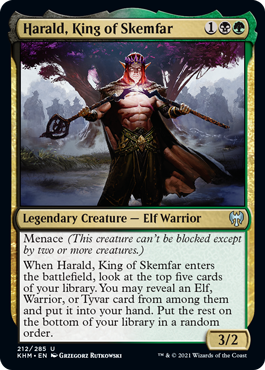
The classic color of elves, Black/Green also has a self-mill plan that can prove wondrous with the right synergies. Harald, King of Skemfar is your legendary uncommon of choice here, and even if it doesn’t draw an extra elf from your deck, it’s still fine as a 3/2 menace for three mana. Draugr Recruiter, Koma’s Faithful, Elderleaf Mentor and Roots of Wisdom are all valuable cards that can help push this plan ahead.
Green/Blue
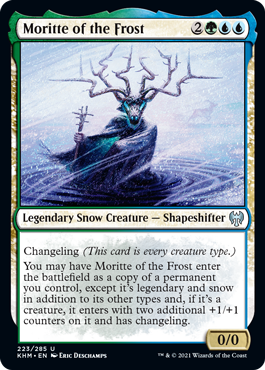
This archetype relies on heavy synergies between either snow or shapeshifters to really work here. Your signature legendary creature is Moritte of the Frost: a strong card that can do amazing work whether it enters as a random creature you already control, or potentially as something as strong as a second Icebind Pillar. Snow lands will be important to this archetype, too, so make sure you draft a few. This deck really comes together if you draft payoffs like Avalanche Caller, Frost Augur, Blizzard Brawl and Boreal Outrider.
Blue/Red
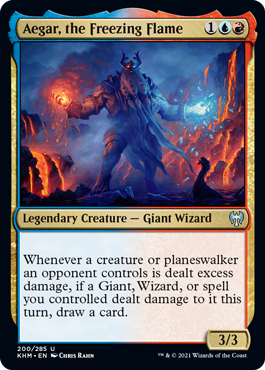
Blue/Red is one of my favorite color pairings, and in Kaldheim, its themes are giants and spells. Aegar, the Freezing Flame, the signature uncommon for this strategy, perfectly epitomizes both of these themes. If you see some late Giant’s Amulet, Glimpse the Cosmos, Squash or Invasion of the Giants in your drafts, you might want to consider moving in while you can!
Red/White
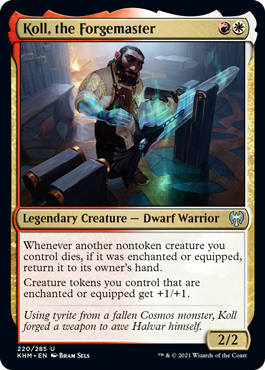
Nasty Boros is the last of the major color pairing archetypes, and in typical fashion, it’s looking to beat your opponent as quickly as possible. The fantastic Koll, the Forgemaster is the legendary uncommon to keep an eye out for; it works so well with any of the myriad equipment and auras you might find for your creatures. Cards like Battlefield Raptor, Dwarven Hammer, Funeral Longboat and Raven Wings are also surprisingly good in this archetype. Don’t sleep on the equipment paired with smaller creatures; they can finish an unsuspecting opponent with relative ease.
These are the most easily identifiable archetypes in Kaldheim – it’s by no means an exhaustive list, and there’s room for innovation and different colors.
Top Cards by Color
These major archetypes are great to keep in mind during your draft, but it’s also helpful to know which individual cards are the most powerful so you can prioritize picking them early. To help you out, I’m going to share what I believe to be the top commons and uncommons in Kaldheim. This is just a cursory glance at the young format and by no means an end-all be-all when it comes to card value, but I hope it provides you with a starting point for evaluating the format. Without further ado, let’s take a look at my top three common/uncommon cards in each color, starting with white.
White
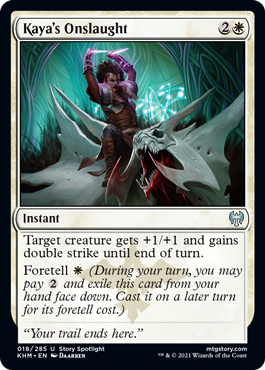
This type of card has always had the ability to end a game out of nowhere. Whether you’re casting it for its full cost or fortelling it, double strike might just be lights out for your opponents.
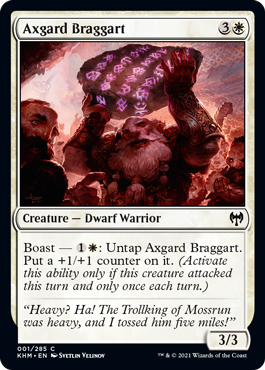
It’s entirely possible I end up rating this way too high, but I want to believe this card is great. At worst, it’s your classic Hill Giant, a 3/3 for four mana, and yet the Axgard Braggart has so much potential. The turn after you play it, it can attack as a 4/4 with vigilance and continue to grow each subsequent tur. If your opponent doesn’t have a way to quickly dispatch it, the Braggart will quickly take over the game at low cost.
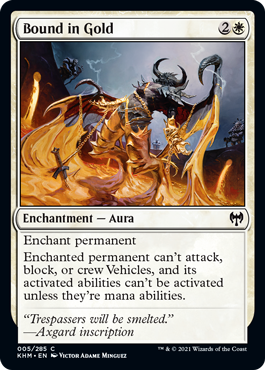
Pacifism, Arrest, Revoke Privileges – we’ve seen these types of cards before, and they always serve a purpose in Limited. The ability to cheaply “remove” a creature from interacting with the battlefield is strong, and Bound in Gold fills this role nicely. While susceptible to enchantment removal, you’re always going to play this card just because of how efficient it is at dealing with a threat.
Blue
#3 Ravenform
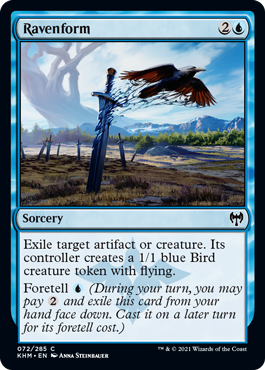
The nicest thing about foretell is that your opponent doesn’t get to know what card you are exiling, so there’s this surprise element that can leave them guessing while you set up. Ravenform does this nicely, as you’re able to cast it for three mana all at once, or only for a single blue mana if you foretold it! A strong removal spell indeed.
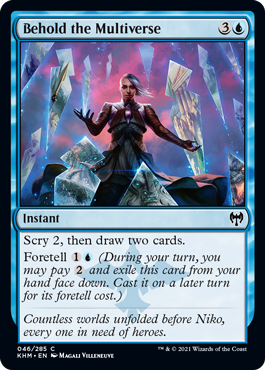
This might be my favorite common of the entire set; it just does everything you could ever want it to do. It allows you to scry and draw cards, it’s an instant, and it even has foretell! This card is simply perfect for both Limited and Constructed, and I will probably play as many copies as I can draft.
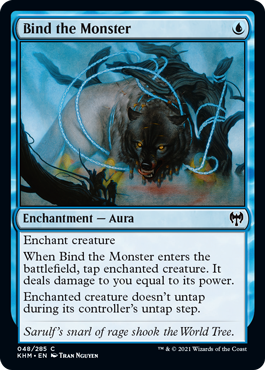
Nowadays, it doesn’t really get much better than this as far as common removal is concerned. People don’t use their life total as a resource often enough, and I’m going to guess that this card is no different. While there will obviously be some awkward situations where you can’t cast it because your life total is already too low, the ease of casting Bind the Monster makes it a very good card in my eyes.
Black
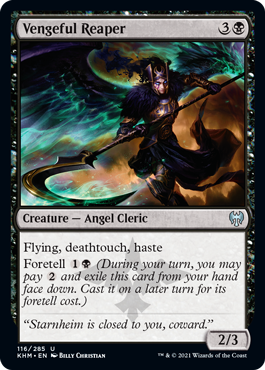
Not too much to say about this effective creature. Decent stats, evasion and deathtouch, all on a creature with a cheap foretell cost makes this a high pickup in my opinion. The best part, perhaps, is that I’m ranking this third, which can only mean the next two cards are spectacular.
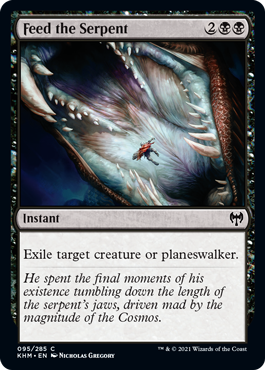
Vraska’s Contempt lite is just simply effective. While the cost is going to prevent all but the boldest from splashing this card in non-black decks, the fact that it’s an instant that permanently deals with a creature or planeswalker makes this the baseline for a common removal spell in the format.
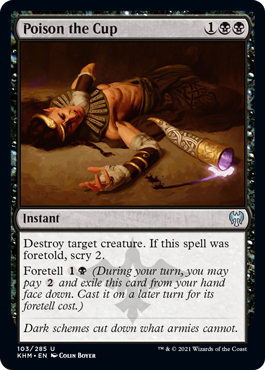
What on earth is this card? I thought Feed the Serpent was a good removal spell, but this is clearly designed with Constructed in mind! While it might not deal with a planeswalker, the versatility AND card filtering with Poison the Cup makes it a disgusting removal spell at uncommon. The best part about this one is that you can early splash for it because the foretell cost only requires a single black mana! I would play as many of this card as I could get in Limited. It’s that good.
Red
#3 Frost Bite
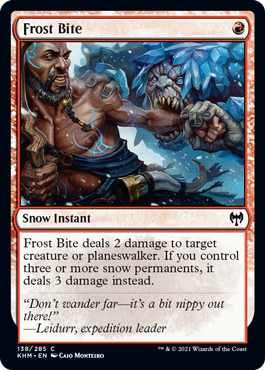
It’s no Shock, but Frost Bite does a fine job for only a single red mana. This is the first “snow” card I’ve listed, and the potential to deal three to a creature if you meet the snow requirement certainly makes this more appealing. Cheap, efficient, effective.
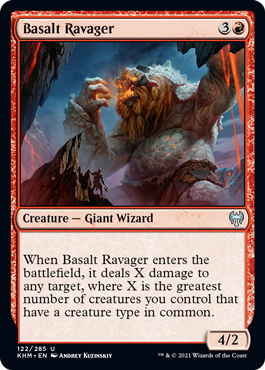
Frost Bite wasn’t Shock, and Basalt Ravager is definitely not a Flametongue Kavu. That being said, it won’t be too hard to make use of the ability, potentially killing a small creature or one that has already taken some amount of damage earlier in the turn. Furthermore, unlike other variants of this card, the Basalt Ravager can actually hit players! With a 4/2 body to boot, this is always going to be a fine addition to your Draft or Sealed decks.
#1 Demon Bolt

Another top card, another removal spell. Similar to quite a few of the removal spells we’ve already covered, Demon Bolt just does too much for what it asks of you. It would already be a fantastic removal spell without the foretell ability, but it simply excels beyond belief with it! Don’t leave home without these – they are going to be snatched up quickly.
Green
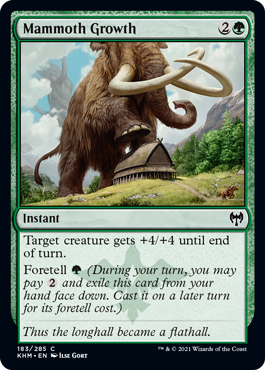
If this were simply a Giant Growth, I don’t believe I would rate it so highly, but once again, we see the power of foretell cards in this new environment. Just simply having a foretell card exiled is going to make your opponent concerned, and Mammoth Growth is a completely reasonable card once you finally do pull the trigger on it. I’m not advocating you play as many as you see, but it’s a nice trick to have.
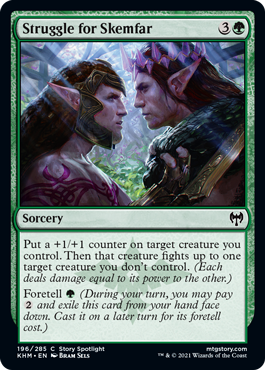
The green removal in this set isn’t close to on par with what some of the other colors have, but Struggle for Skemfar is at least decent. This is simply a better Hunt the Weak for a variety of reasons, one of which is, of course, the ability to foretell it. You’ll also notice that this card is worded in a way that allows you to choose if you want to fight or not, thereby removing the need for your opponent to have a creature in the first place. Solid spell, all in all.
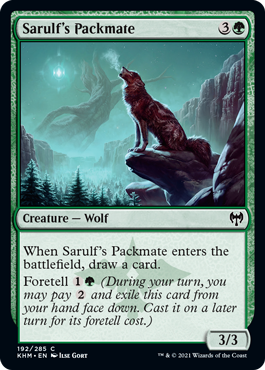
I think this card is just great. A four-mana 3/3 that draws a card is already fine, in my opinion, and once again, foretell bumps up the power of a card that would overwise just be fine. I can’t overstate just how good foretell is going to be, and I’m certain that this is going to be one of my most played green commons because of it.
That brings us to the end of the mono-colored cards, and I must say that we have quite the selection to work from. A quick cursory glance tells me that white has the weakest cards for Limited gameplay, while black has some of the most powerful. There’s a large assortment of multicolored cards in Kaldheim as well, but I’ve opted not to rate them; there are so many powerful cards to choose from that I don’t believe you can go wrong.
As with all new sets, we’ll learn the most about this format by playing it, but I’m hoping that this overview will give you a good idea of what cards you should keep an eye out for. My advice, as always, is to play with what you enjoy and learn a new format through trial and error.
Kaldheim hits stores soon, so don’t forget to check out the Card Kingdom online store for all of your preorder needs. If you want to catch me playing with the new cards once they’re available online, you can always join me on my Twitch channel, where I stream every weekday.
Thanks for reading, and I hope to see you in my chat soon!

Better known as his online handle, “NumotTheNummy,” Kenji Egashira has played Magic for over 20 years. An enthusiast of all things Limited, you can almost always find him streaming on his Twitch page over at twitch.tv/numotthenummy.

